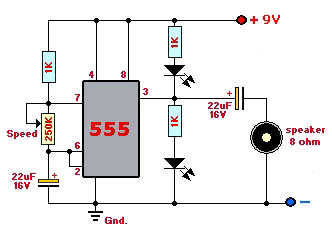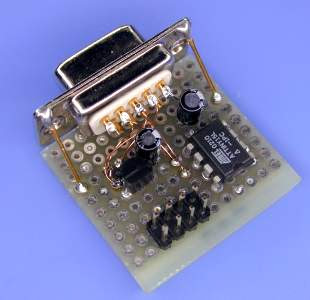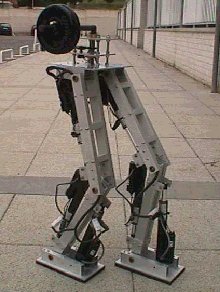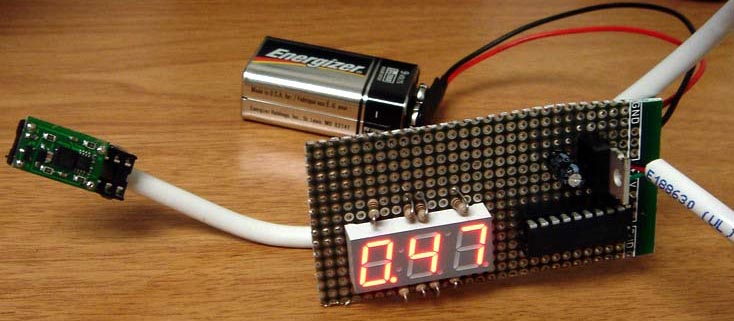RF and IR Remote Control
PS to USB Joystick Converter
note : no picture for the project, i just replace it with analog PS 1 joystickDownload :
source code and schematic
search term : PS to USB, Converter, Microcontroller Project (src)
Electronic Tools : Weller WLC100 Soldering Station
The Weller WLC100 Soldering Station includes everything you need to start using solder to join metals and create efficient, electrical connections. Designed with the hobbyist and the do-it-yourself enthusiast in mind, this kit features a high-quality, lightweight pencil iron with variable power control, a cushioned foam grip with a replaceable heating element, and a safety guard iron holder. And it’s from Weller, the world leader in soldering since 1945.
Scroller 7 × 5 LEDs based on Attiny2313
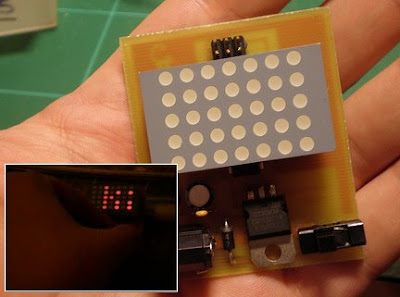 Cool microcontroller project from kalinda. In this project he used microcontroller AVR Attiny2313 that is perfect for controlling the 13 pins required for the matrix of LEDs. he has also provided pins in the most optimal order to occupy as little as possible.
Cool microcontroller project from kalinda. In this project he used microcontroller AVR Attiny2313 that is perfect for controlling the 13 pins required for the matrix of LEDs. he has also provided pins in the most optimal order to occupy as little as possible.
List of materials
- Programmer for AVR micros (AVRisp MKUII in my case)
- Microcontroller Attiny2313 with fuses configured for internal oscillator 8Mhz
- 1x Display 5 × 7 leds Kingbright
- 1x voltage regulator 7805
- 1x battery or source of food 9v
- 2x Capacitors 100uF
- 2x Capacitors 100nF
- 5x Resistances 90 Ohms
Required Software
- Kalanda Led Composer to generate animations.
- WinAVR and AVR Studio to compile the source.
- Source code firmware for Attiny2313
Drawings and plates
[link]USB AVR Programmer STK500
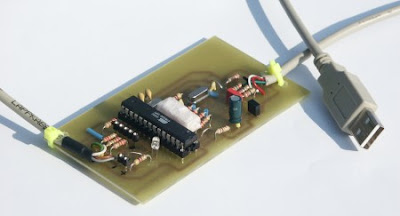 In this microcontroller project, Guido Socher design a state of the art USB programmer for the AVR microcontrollers from Atmel. The programmer firmware has no device dependent data. Therefore it works for almost any AVR microcontroller on the market and possible future microcontrollers.
In this microcontroller project, Guido Socher design a state of the art USB programmer for the AVR microcontrollers from Atmel. The programmer firmware has no device dependent data. Therefore it works for almost any AVR microcontroller on the market and possible future microcontrollers.This USB programmer has, unlike other programmers, no "chicken and egg problem". That is: you can build it from scratch without the need of another programmer to load the initial firmware.The firmware is open source and programmed in C according to the AVR068 specification from Atmel.
[link]
AVR Infrared Link Project
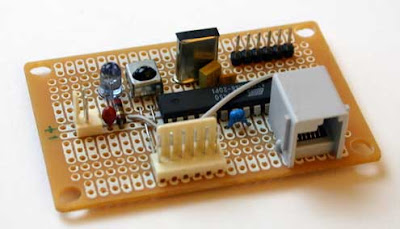 This AVR microcontroller project created by Sivan Toledo. In this project he created an infrared (IR) link that provides bi-directional communication between the NXT and the new Power-Functions system, which consists of a battery box, motors, a remote control (an IR transmitter) and an IR receiver that controls the motors.
This AVR microcontroller project created by Sivan Toledo. In this project he created an infrared (IR) link that provides bi-directional communication between the NXT and the new Power-Functions system, which consists of a battery box, motors, a remote control (an IR transmitter) and an IR receiver that controls the motors.He previously built an IR transmitter for the NXT which used an MSP430 microcontroller and which was able to send Sony IR commands. In this project, he wanted to achieve three additional goals:
- To analyse the Power-Functions IR protocol.
- To build a system that could not only send IR commands, but could also receive and decode them.
- To experiment with AVR's, another family of microcontrollers.
[Link]
AVR Infrared Link Project
 This AVR microcontroller project created by Sivan Toledo. In this project he created an infrared (IR) link that provides bi-directional communication between the NXT and the new Power-Functions system, which consists of a battery box, motors, a remote control (an IR transmitter) and an IR receiver that controls the motors.
This AVR microcontroller project created by Sivan Toledo. In this project he created an infrared (IR) link that provides bi-directional communication between the NXT and the new Power-Functions system, which consists of a battery box, motors, a remote control (an IR transmitter) and an IR receiver that controls the motors.He previously built an IR transmitter for the NXT which used an MSP430 microcontroller and which was able to send Sony IR commands. In this project, he wanted to achieve three additional goals:
- To analyse the Power-Functions IR protocol.
- To build a system that could not only send IR commands, but could also receive and decode them.
- To experiment with AVR's, another family of microcontrollers.
[Link]
Digital Clock with PIC16F84A
 This is a small ajustable clock based on microcontroller PIC16F84A microchip.The electronic project here is very simple because the hardware only uses 74hct238 demultiplexer, 4x7 segments, and some resistors. The software is programmed through a device connected to serial port with icprog and made/debuged with MPlab. For PIC Programmer you can use JDM PIC16F84A programmer.
This is a small ajustable clock based on microcontroller PIC16F84A microchip.The electronic project here is very simple because the hardware only uses 74hct238 demultiplexer, 4x7 segments, and some resistors. The software is programmed through a device connected to serial port with icprog and made/debuged with MPlab. For PIC Programmer you can use JDM PIC16F84A programmer.[link]
Serial Port IR Receiver Using AVR
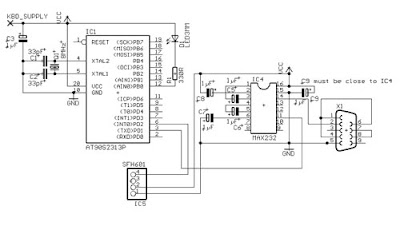 Another cool microcontroller project created by Klaus Stock. He said, this is a simple IR receiver circuit which plugs into a serial port of a computer. This circuit has two major advantages:
Another cool microcontroller project created by Klaus Stock. He said, this is a simple IR receiver circuit which plugs into a serial port of a computer. This circuit has two major advantages:1. it uses an Atmel AVR RISC microcontroller (an AT90S2313) instead of the usual PIC microcontroller and
2. it uses a Maxim MAX232 for the generation of valid RS232 levels.
Advantage 1 is, of course, only valid for all those AVR addicts which have this device (and the corresponding programmer) ready at hand and don't care about PICs and PIC programmers. Advantage 2 comes into play if the IR receiver has to placed at a great distance from the computer; the MAX232 is more likely to deliver valid signals over bigger distances than cheaper solutions.
[Link]
Serial interfacing LCD with PIC Microcontroller
 Parallel interfacing LCD with MCU at least need 6 I/O pins (4 bit mode) and maximun can up to 11 I/O pins (8 bit mode). The I/O pin can be cut down to 3 pin by serial iterfacing using shift register. They were few shift register can be used such as 74HC164, 74HC595, CD4094 and any compatible 8 bit shift register. Before you attempt to do serial interfacing, it is good pratice to familiar with parallel interfacing. You can find many reference from internet.Following diagram show the serial interfacing Hitachi compatible 2 X 16 LCD modules with Pic16F84 or Pic16F628 MCU.
Parallel interfacing LCD with MCU at least need 6 I/O pins (4 bit mode) and maximun can up to 11 I/O pins (8 bit mode). The I/O pin can be cut down to 3 pin by serial iterfacing using shift register. They were few shift register can be used such as 74HC164, 74HC595, CD4094 and any compatible 8 bit shift register. Before you attempt to do serial interfacing, it is good pratice to familiar with parallel interfacing. You can find many reference from internet.Following diagram show the serial interfacing Hitachi compatible 2 X 16 LCD modules with Pic16F84 or Pic16F628 MCU.Download documentation and source code for serial interfacing LCD with PIC here (zip file)
[link]
Multifunction Digital Thermometer
 This instructable will show you how to create a multifunction platform with a thermometer, chronograph (count up timer), count down timer, and light display. It is also intended to be a platform for other analog sensors or any other functions you can think of. Project is based on Atmega168 microcontroller. Information is displayed on dual 7 segment LED display.
This instructable will show you how to create a multifunction platform with a thermometer, chronograph (count up timer), count down timer, and light display. It is also intended to be a platform for other analog sensors or any other functions you can think of. Project is based on Atmega168 microcontroller. Information is displayed on dual 7 segment LED display.Multifunction Digital Thermometer [link]
Simple Metronome Project
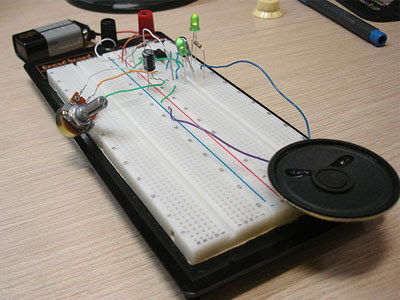 Daniel designs this Metronome with a few simple electronic components.The Metronome is any device that produces a regulated audible and/or visual pulse, usually used to establish a steady beat, or tempo, measured in beats-per-minute (BPM) for the performance of musical compositions. It is an invaluable practice tool for musicians that goes back hundreds of years.
Daniel designs this Metronome with a few simple electronic components.The Metronome is any device that produces a regulated audible and/or visual pulse, usually used to establish a steady beat, or tempo, measured in beats-per-minute (BPM) for the performance of musical compositions. It is an invaluable practice tool for musicians that goes back hundreds of years.
Material Needed:
2. 3x 1K Ohm Resistor
3. 2x 22uF 16V Capacitor
4. 9V Battery
5. 8 Ohms Speaker
6. 250K Ohms Potentiometer
[link]
AVR Temperature Meter
In this project, the A-D converter is used as four channels, single-ended, no gain and VREF from Vcc configuration. However RSTDISBL fuse must be programmed in order to use pin #1 as one of the analog inputs, an AVR programmer that can program in HVS mode is required."
For documentation, schematic dan code, download here
[link]
Interfacing DRAM Memory with AVR

But, the consequency is it will be relatively slow and put some extra load on the CPU, but if you need a cheap, large RAM memory and can accept the overhead, this is the way to go. But, with more bigger memory you get. It would not to bad to try isn't.
If you need source code, schematic, and documentatiaon about this microcontroller project click here (zip).
Another project by jesper
1. AVR digital counter
2. Temperature Controller
[via]
Digital Guitar Tuner
 "This microcontroller project is a simple, but accurate for Digital Guitar Tuner. It samples the input, which can be directly from the mics of an electric guitar, or from a microphone, it you're using an acoustic guitar. The circuit also can be used for tuning other instruments."
"This microcontroller project is a simple, but accurate for Digital Guitar Tuner. It samples the input, which can be directly from the mics of an electric guitar, or from a microphone, it you're using an acoustic guitar. The circuit also can be used for tuning other instruments."The samples are then checked against stored values for the strings, and the two LED's will show the tuning status - "Too Low", "Too High" or "In Tune" when both LED's are lit. The tuner will automatically switch between the six strings. The circuit is pretty simple. A small transistor amp pumps up the input signal to something the AVR can see on it's input pin. The other two I/O pins are used for driving the LED's. The input sensivity is around 50-60 mV. This gives a 2-3 V swing on the input pin, enough for the 2323 to read this as high and low levels.
If you interest to build this project, you can download the document, source code, schematic here (zip file)
[link]
TV-B-Gone Project
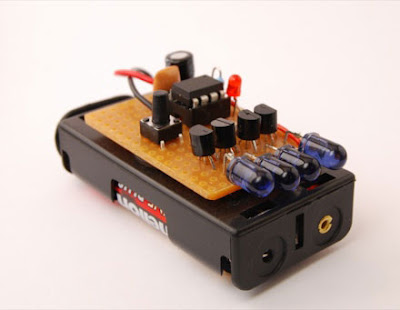
TV-B_Gone is another fun DIY microcontroller project. It's a simple remote control for TV that has function only Turn Off. So, there is only one button, power button. No Longer dumb advertisemsent on your TV, just use this cool microcontroller project to switch it off.
You can get this device on the market. But if you want to build it by yourself there are good news for you. Lady Ada an Mitch has build an open source version of the TV-B-Gone. it means you can download the schematic and the layout based on open source license.
How does it work?
If you hit the button it plays simply every shut down code stored in microcontroller and send it out to IR led. The transistors are used to drive a stronger current through the IR-LEDs. The latest TV-B-Gone kit have a range of about 50 meters. For the power supply you can use two battery AA.
Card Reader using Microcontroller
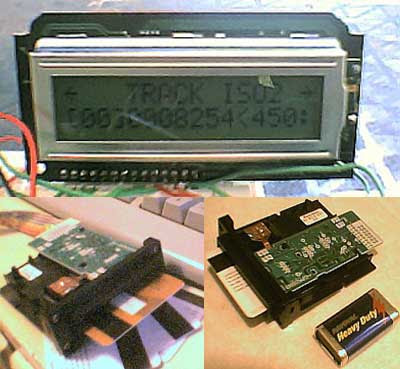 This is a simple version of Card Reader. Why? because this Magnetic Card Reader only in read only environment. It only read the information stored in magnetic card. The purpose of the project is used as card debugger. There are three main part in this project :
This is a simple version of Card Reader. Why? because this Magnetic Card Reader only in read only environment. It only read the information stored in magnetic card. The purpose of the project is used as card debugger. There are three main part in this project :
- A reader to capture digital characters from the card
- A RISC microcontroller to store data and check for errors
- A display to relay the magstripe contents to the viewer
"The Magstripe (Track 2) Reader project can be used to view numerics stored a magnetic data card. Although there is no writeback ability, the device is very useful as a card debugger. The treatise will use an LCD character display to relay this data to the user. The circuit uses an AVR microcontroller and can modified to work with similar RISC controllers."Although the card reader can't write back to magnetic card, I guess this is a one of good reference to learn how card reader work. For download the reference clik here (zip file)or visit this link
Thanks to Brady Mayes for great card reader based on microcontroller.
[via]
Controlling AVR with Visual Basic
 The purpose of this microcontroller project is to give the student a figure out about How to Control AVR Devices using Visual Basic (PC). To comunnicate between PC and Microcontrller, it use RS232. So, this is not a stand alone project. From this general microcontroller project the student can improve and made more specific to meet their requirement. This project creted by Serasidis
The purpose of this microcontroller project is to give the student a figure out about How to Control AVR Devices using Visual Basic (PC). To comunnicate between PC and Microcontrller, it use RS232. So, this is not a stand alone project. From this general microcontroller project the student can improve and made more specific to meet their requirement. This project creted by Serasidis"The use-range of this application is very high. You can make, anything you want, that its need control from PC computer or some circuit that is collect data from somewere, and at the end, its give this data to PC computer via RS232 port to our software"
For VB code, schematic, document you can download here (i've collected them in one zip file)
NiCd/NiMH Battery Charger
 Commercial NiCd/NiMH Battery Charger, As you may have noticed, are not that Efficient when it comes to charging time. There might be some expensive models but we are not referring to that. One of the solution is using Intelligent NiCd/NiMH Battery Charger created by Peter Hayles. This Efficient NiCd/NiMH Battery Charger build using microcontroller PIC 16C711. Because it will reduce the complexity of the circuit. He says that with the DIY charger he managed to cut the charging time from 4 hours to 1.5 hours max. This sound good to me.
Commercial NiCd/NiMH Battery Charger, As you may have noticed, are not that Efficient when it comes to charging time. There might be some expensive models but we are not referring to that. One of the solution is using Intelligent NiCd/NiMH Battery Charger created by Peter Hayles. This Efficient NiCd/NiMH Battery Charger build using microcontroller PIC 16C711. Because it will reduce the complexity of the circuit. He says that with the DIY charger he managed to cut the charging time from 4 hours to 1.5 hours max. This sound good to me.
"This cheap and easy to build NiCd/NiMH Battery Charger is suitable for automatically charging a wide range of batteries for many applications. Proper chargers are usually expensive and cheap chargers supplied with the original equipment often incorrectly charge the cells and dramatically shorten their life. This 'intelligent' charger was designed for high current and rapid charge applications such as cordless power tools and model racing cars."Download for the schematic and document (Zip file), click here.
Digital camera interface
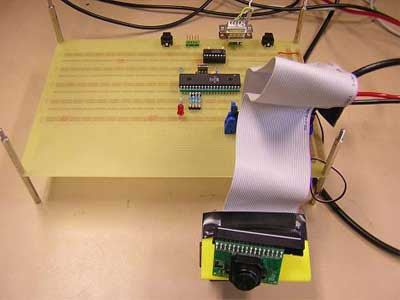
Download code, schematic, slide and documentation click here
Data Acquisition & Logging System
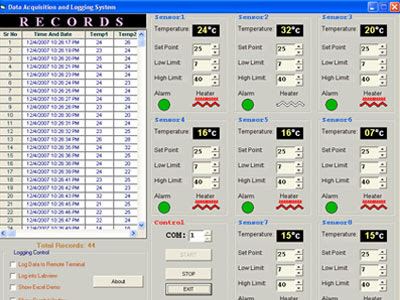 This microcontroller project log the temperature system. It can be used to monitoring and controlling environment temperature as we needed. i know that the chip, AT89C51, little out of date, but at least we can still learn the system How to make Data Acquisition & Logging System with microcontroller. This great project made by Abbas Raza
This microcontroller project log the temperature system. It can be used to monitoring and controlling environment temperature as we needed. i know that the chip, AT89C51, little out of date, but at least we can still learn the system How to make Data Acquisition & Logging System with microcontroller. This great project made by Abbas Raza"The status and temperature date saved to PC via serial communication. Here 8 temperature sensors are connected(4 shown in diagram for simplicity). values of all the sensors are sent serially by AT89C51 to pc. Software "DAQ System " takes these values and show them on its front panel, and also logs them to the data base "daq.mdb" .we can set some parameters like set point , low limit ,and high limit . when temperature of some sensor increases beyond set point ,the heater connected to controller (specific for that sensor) will be turned OFF( ON in opposite case ).High limit and low limits are for alarm. when temperature goes above high limit or below low limit the alarm will be turned on."
For complete reference, source code, Schematic, you can download here.
The Strength of 8-bit
 When Renesas was formed in 2003, they took Mitsubishi's successful low-power M16C 16-bit core, added Hitachi's sophisticated peripherals, and created a modern microcontroller that is easy to learn. Targeted towards efficient, low cost applications, this is now one of the most popular 8/16-bit microcontrollers available. This 8-bit Flash microcontroller family is the Renesas R8C.
When Renesas was formed in 2003, they took Mitsubishi's successful low-power M16C 16-bit core, added Hitachi's sophisticated peripherals, and created a modern microcontroller that is easy to learn. Targeted towards efficient, low cost applications, this is now one of the most popular 8/16-bit microcontrollers available. This 8-bit Flash microcontroller family is the Renesas R8C.FEATURES OF THE RENESAS R8C 8-BIT MICROCONTROLLER INCLUDE :
- Optimized 20MHz R8C CISC Core
- 8-bit internal data paths with a 16-bit
- ALUCore data registers configurable as 8-bit, 16-bit, or 32-bit
- CPU Address Registers configuration: 16-bit or 32-bit configuration
- Dual data registers for fast context switching - see animation -->
- Hardware Multiplier performs a 16x16 multiply in 5 cycles
- Sub 1µA standby mode
- Entire Flash array is byte-writable
- Single-Cycle Memory Access
- Data Transfer Controller (similar to a DMA) provides high-speed data transfer with no CPU intervention
- Data types: -> Signed or unsigned integer (8-bit) -> Signed or unsigned word (16-bit) -> Signed or unsigned long word (32-bit) -> Packed decimal
- Vectored interrupts with seven levels of priority
- One wire on-chip debug with trace, and break on data and address
- Automotive Grade available
Thesis on IMPLEMENTING A ROBUST 3-DIMENSIONAL EGOCENTRIC NAVIGATION SYSTEM
Robotic Arm Project
For Detail Download
Project on Design of a Biped Robot with Efficient Motion Control
Car Anti-Theft Wireless Alarm
 This alarm circuit is an anti- theft wireless alarm can be used with any vehicle having 6- to 12-volt DC supply system. The mini VHF FM radio-controlled, FM transmitter is fitted in the vehicle at night when it is parked in the car porch or car park.
This alarm circuit is an anti- theft wireless alarm can be used with any vehicle having 6- to 12-volt DC supply system. The mini VHF FM radio-controlled, FM transmitter is fitted in the vehicle at night when it is parked in the car porch or car park.
When an intruder tries to drive the car and takes it a few metres away from the car porch, the radio link betw- een the car (transmitter) and alarm (receiver) is broken. As a result FM radio module gene-rates hissing noise. Hissing AC signals are coupled to relay switching circ- uit via audio transformer. These AC signals are rectified and filtered by diode D1 and capacitor C8, and the resulting positive DC voltage provides a forward bias to transistor T2. Thus transistor T2 conducts, and it pulls the base of relay driver transistor T3 to ground level. The relay thus gets de-activated and the alarm connected via N/C contacts of relay is switched on.
If, by chance, the intruder finds out about the wireless alarm and disconnects the transmitter from battery, still remote alarm remains activated because in the absence of signal, the receiver continues to produce hissing noise at its output. So the burglar alarm is fool-proof and highly reliable. (Ed: You may have some problem catching the thief, though, if he decides to run away with your vehicle_in spite of the alarm!)
Go to Car Anti-Theft Wireless Alarm Forum
Interfacing microcontroller avr to GPS mobile phone

Materials
The first idea was to combine a microcontroller with a GSM and a GPS modul. There are a lot of these modules over at Sparkfun, for example. Finally he choose Telit GM862, which is a GSM modul with an built in GPS receiver. Sparkfun sell great break out boards to make it easier for hobbyist to access these modules.
Here are some of the features of this GSM-GPS module:
- Quad band GSM
- 17mA average stand-by, 3.5mA in low-power mode
- 250mA average operating current
- SiRF III GPS Receiver Built In
- Data, Voice, SMS, and Fax
- Data speeds up to 57.6kbps
- Supply voltage : 3.4-4.2V
- CMOS Camera Capable
- Python Interpreter built-in
Dot Matrix Scrolling Sign based on Microcontroller AVR

"The Dot Matrix Display has an 5x7 led matrix with 5 columns and 7 rows.The display is controlled by the ATTiny2313 microcontroller. The rows are controlled by PORTB of the microcontroller, while PORTD puts the data on the columns to make the characters. The Dot matrix display used here is the LTR-747HR and is 0.7 inch (17.8mm) high."View Schematic and download source code (.bas)
note: picture take from tinkerlog photostream. Not related to this project
link
Infrared Remote Control Receiver

For remote control receiver that it could handle both On/Off and windows or program commands you cand use Girder 3.2.9 or PC remote control v4.213. This receiver use RS232 port to communicate with PC at 2400bps.
For more detail about source, schematic and more, you can download here
AVR Digital Counter

"It uses only 4 chips - 3 HC TTL's and an Atmel At90S2313 microcontroller. It has a 5 digit LED display plus one used as a band indicator. Even with the LED display, the current consumption is less than 50 mA. It counts up to at least 52 MHz. I couldn't find any signal source in the lab that could supply more than 52 MHz, so it may go a bit higher, but the fClock(typ) for the HC590 is about 35-40 MHz, so you shouldn't really count (no pun intended) on more."View Schematic and download source code for counter measurer.
Tempereature Controller using Microcontroller AVR

The project use C language to programm it, will make everything more easier. A 4 MHz ceramic resonator is used for clocking the 2313. "A fun little construction and a good way to learn about the DS1621" Jesper said. This could be a good microcontroller project for you who want to learn How to interface DS1621 to Micorocntroller AVR using I2C protocol.
View Schematic and download the project code
Fireflies based on tiny AVR
 This circuit simulates fireflies with small microcontrollers. Here is the circuit and the component used for single fireflies
This circuit simulates fireflies with small microcontrollers. Here is the circuit and the component used for single fireflies
- ATtiny13 microcontroller
- Light Dependant Resistor (LDR)
- LED
- 2 resistors
 link
link
Phone Line controller PIC 16F84A

Download schematic, description, hex files
Color TFT LCD Controller
 Michal Sieluzycki from US has created great innovation using ATmega8515. He won Grand Prize from AVR 2004 Design Contest.
Michal Sieluzycki from US has created great innovation using ATmega8515. He won Grand Prize from AVR 2004 Design Contest.The zip Drive and Digital Camera using ATmega8535
 Project Description :
Project Description :Link : The zip Drive and Digital Camera using ATmega8535
Embedded Ethernet MiniCore™ from Rabbit!
 The RCM5700 Development Kits have that you need to quickly design a very small Embedded Ethernet microprocessor-based system. Choose either a standard or deluxe development kit. Both kits includes RCM5700 microprocessor core module, development board with prototyping area and complete documentation on CD-ROM, and a Getting Started manual. A USB cable is included. The deluxe kit will include power supplies, and additional protyping boards for specific sample programs. Both development kits come with Rabbit's industry-proven Dynamic C integrated development software that includes an editor, compiler, and in-circuit debugger. Programming is easy with hundreds of samples and libraries that can be used as building blocks to your code.
The RCM5700 Development Kits have that you need to quickly design a very small Embedded Ethernet microprocessor-based system. Choose either a standard or deluxe development kit. Both kits includes RCM5700 microprocessor core module, development board with prototyping area and complete documentation on CD-ROM, and a Getting Started manual. A USB cable is included. The deluxe kit will include power supplies, and additional protyping boards for specific sample programs. Both development kits come with Rabbit's industry-proven Dynamic C integrated development software that includes an editor, compiler, and in-circuit debugger. Programming is easy with hundreds of samples and libraries that can be used as building blocks to your code.DIY Dual Fan Controller Project
Here’s a nice little circuit diagram for all those hardcore DIYers if you are trying to build a dual fan controller using an ATtiny45 although I’d never use this thing, I’d rather use a CUBLOC.
"Over the course of a weekend, I cobbled together some leftover robot parts to create a simple dual-fan controller. The board turns on the first fan when the temperature reaches a user-adjustable dial setting, and it turns on a second fan if the temperature exceeds an additional 5 degrees Fahrenheit. With this method, only a single fan is used if the temperature can be kept under control with only one fan, but both fans will kick on if necessary."
Twitter Hack – How to Make a Laser-Trip Webcam Security System!
Here’s a great Twitter Hack that involves Arduino, Linux, webcam, and a laser pointer to make it a complete Twitter Security System! Awesome, this is the best use of Twitter I have seen so far, simple yet effective webcam security system!
"This instructable will show you how to construct a laser tripwire that can twitter and grab an image from a webcam, as well as execute any command you can put in a bash script.This instructable is actually quite simple and is even suitable as a beginner arduino project. It requires a GNU/linux (or possibly Mac) operating system with the arduino IDE and Processing IDE working properly. This project could also be implemented in Windows if you created a more complex processing application."
DE-ACCM5G Application Note G Meter for your car
Here’s an article about how to make a G-Meter for your car. link
Wireless Graphic LCD

Required Parts :
- 2 ACODE-300 Bluetooth modules
- 1 ACODE Interface Board
- 2 LEDs
- 1 LM3940 or any 5-to-3.3v regulator
- 1 15K and 30K resistors
- 1 GHLCD graphic LCD (or any serial LCD)
- 6 4-pin sockets (or simply cut a 16-pin socket like me~)
- 1 CUBLOC or some type of microcontroller
- 1 CUBLOC Study Board or some type of microcontroller
Low Budget Oscilloscope with Graphical LCD Display:
A 9V battery is used as the power supply along with a high-accuracy low drop-out linear voltage regulator to provide a stable 5V supply for the microcontroller and the graphical LCD. The power spikes/ripples are prevented by capacitor.
Battery Low Voltage Beeper
U2 provides a 5V regulated voltage reference. U1 is wired as a comparator, it compares the fixed 5V regulated voltage to the voltage on the wiper of VR1, that is proportional to the 12V supply. When the supply drops below the set point, the output of U1 goes low, turning on Q1 and powering the beeper and the LED.
The beeper consists of U4, a tone generator, and U3, a low duty cycle pulse generator. The tone can be changed by adjusting R7, the beep rate can be changed by adjusting R5. A small amount of hysteresis is provided by R1 and the current through LED1 and the beeper, this separates the on and off points for the circuit.
U2 provides a 5V regulated voltage reference. U1 is wired as a comparator, it compares the fixed 5V regulated voltage to the voltage on the wiper of VR1, that is proportional to the 12V supply. When the supply drops below the set point, the output of U1 goes low, turning on Q1 and powering the beeper and the LED.
The beeper consists of U4, a tone generator, and U3, a low duty cycle pulse generator. The tone can be changed by adjusting R7, the beep rate can be changed by adjusting R5. A small amount of hysteresis is provided by R1 and the current through LED1 and the beeper, this separates the on and off points for the circuit.
Use of Battery Low Voltage Beeper
Connect the circuit to the 12V source that you wish to monitor. Turn S1 on, if the battery voltage is above the set point, nothing should happen.
As the battery voltage drops below the set point, the LED will light and a periodic beeping will come from the speaker. If the beeping becomes annoying, turn off S1. Be sure to charge the battery soon, excessive discharging will shorten the life of most rechargeable batteries.
More about Battery Low Voltage Beeper
Parts Lists : Printed Circuit Image (PostScript File) Component Placement Silkscreen (PostScript File)
Tutorial : MiniPOV based on microcontroller AVR AT tiny 2313
 Did you like electronic project especially related to LED? if you do, then MiniPOV is a great electronic project for you. It's a simple project, but it will amaze you when you finish build it. MiniPOV is one of Persistence of Vision that give eye illution patern when it swinged in the air. This cool project made by Ladyada. This project based on microcontroller AVR ATtiny 2313.
Did you like electronic project especially related to LED? if you do, then MiniPOV is a great electronic project for you. It's a simple project, but it will amaze you when you finish build it. MiniPOV is one of Persistence of Vision that give eye illution patern when it swinged in the air. This cool project made by Ladyada. This project based on microcontroller AVR ATtiny 2313. You wanna try to build it. Here is step by step to make cool Mini POV. Just use your imagination to make another great POV
You wanna try to build it. Here is step by step to make cool Mini POV. Just use your imagination to make another great POV


